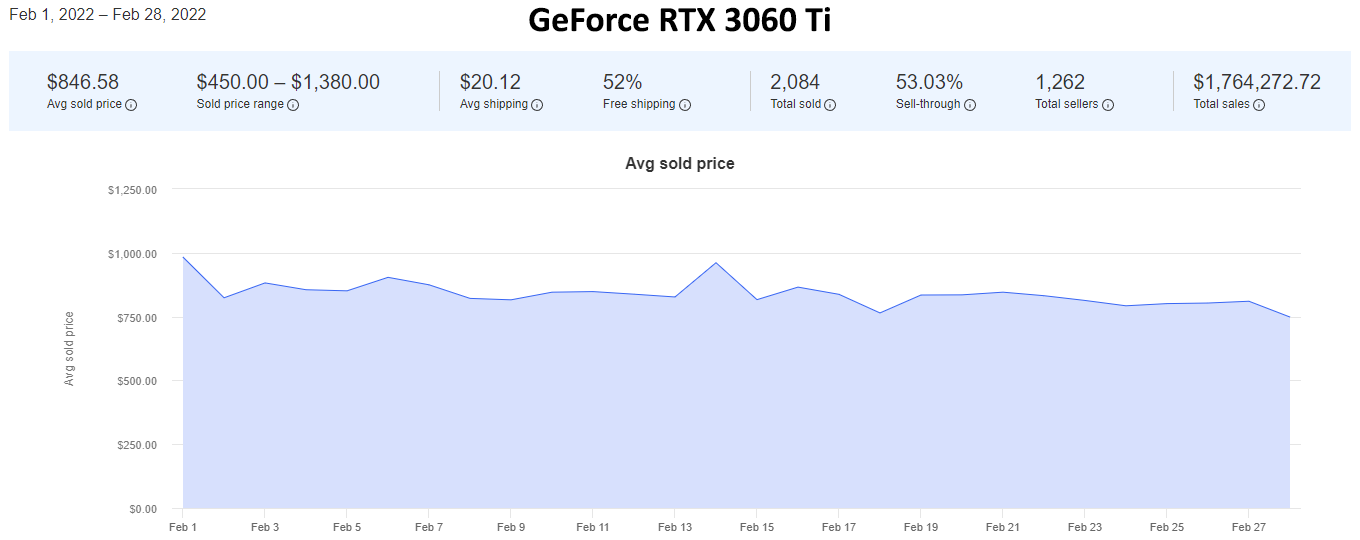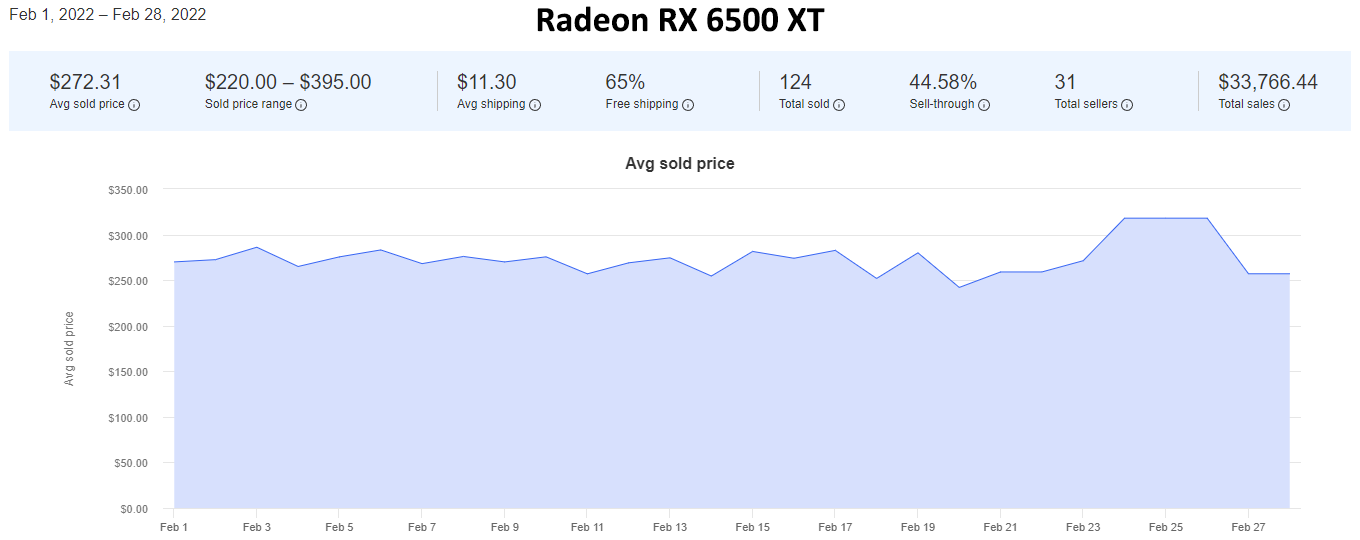Graphics Card Prices Dropped 11% in February
The last time you could buy one of the best graphics cards for anything close to MSRP was nearly two years ago, just before the pandemic hit. At the time of the GeForce RTX 3080 launch, we mistakenly thought it was just initially high demand and recommended that no one pay scalper prices of $1,000 or more. Hindsight shows just how wrong we were. But now, with the recent downward trends in GPU prices showing another 11% month-over-month drop, there may be light at the end of the tunnel.
We've gathered the data for the month of February and compared it with pricing from January — using eBay prices, since that's readily available. (Most retail outlets don't provide historical sales and pricing information.) The good news is that, at least for the time being, it appears we've passed the peak and are headed down. The bad news is that there's still a long, long way to go. Here's a look at the past two generations of GPUs, all in one table:
Not a single GPU managed to hold its former price, which is great to see. Normally, there's a bit of variance where maybe a few GPUs still go up in price even though most drop, but that's not the case this time. The biggest losers were the GTX 1660 Super, RTX 3070 Ti, GTX 1650 Super, and RTX 2060 — though we're not counting the RX 6500 XT and RTX 3050, since both of those launched in January and only had limited availability during that month.
The majority of GPUs showed double-digit percentage drops in pricing, with 20 of the 33 cards falling in that range. In fact, only two GPUs showed less than a 7% drop in price, the RX 5500 XT 4GB and 8GB cards. Perhaps that's because they were already near the bottom of the pricing ladder, or maybe it's because the RX 6500 XT proved to be quite anemic, often trailing its ancestors in performance.
















If you prefer a more granular look at prices, the above gallery shows the eBay pricing trends for all 16 of the current generation RTX 30-series and RX 6000-series graphics cards. Some show an obvious downward slope over the entire month of February, while others tended to be a bit more variable. But when we look at the GPUs sold for the entire month, the trends become clear.
Taken as a whole, this is great news, but prices remain drastically inflated. The best "deals," if we compare current eBay prices to the official AMD and Nvidia MSRPs, are still at least 35% higher than the MSRPs. Even then, MSRPs on many of the cards are quite a bit higher than what we would normally expect. The RX 6500 XT, for example, "only" costs 36% more than the $200 MSRP, but historically, a budget design like this with a 64-bit memory interface would have sold for closer to $120. The 3070 Ti and 3080 Ti likewise suffer from inflated MSRPs.
Based on theoretical price and performance, the most desirable cards are the RTX 3080, RTX 3060, RX 6800 XT, and RX 6600. Of those, only the RX 6600 has a somewhat reasonable price that's only 40% higher than the MSRP. The RX 6800 XT costs 80% more than the MSRP, while the RTX 3060 and 3080 sell for more than twice the official Nvidia price.
The GPU Outlook for the Rest of 2022
Looking forward, how long will it take for things to return to "normal" if the current trends continue? First, big disclaimer: It's impossible to predict where prices will go in the coming months. The extremely volatile cryptocurrency market has a strong influence on GPU prices, and there are still a lot of difficulties with the supply chain. But if these latest trends were to continue, best-case, we'd start to see some GPUs like the RX 6600 and RX 6500 XT selling at MSRP in about three months. Cards like the RTX 3080 would require closer to seven months. But again, there's basically zero chance we'll see a steady and continuous 10% drop in prices each month for the next half a year.
There are plenty of other things to look forward to in six months as well. Most pundits (including us) expect Nvidia to launch its next-generation Ada Lovelace / RTX 40-series GPUs in the fall. With all rumors and leaks indicating a move to TSMC's 5nm N5 process instead of the current Samsung 8nm 8N, we could be in for a major performance improvement. At the same time, TSMC N5 wafers will cost significantly more than Samsung Foundry's 8N wafers, and there's a good chance we'll see generational pricing increase quite a bit.
AMD has also stated that it plans to launch RDNA 3 / RX 7000-series graphics cards this year. Again, late fall would make the most sense, and there's a good chance TSMC's N5 node will get the nod again. If correct, that will make for an interesting apples-to-apples comparison, as both companies will have access to the same lithography, leaving the underlying GPU designs to fight it out and declare a winner.
And let's not forget Intel, either. We're not expecting Intel Arc to attack the top of the performance stack, but there's definitely an opportunity for Intel to undercut the pricing offered by its competitors. Rumors suggest the fastest Arc GPUs could come close to the RTX 3070 and RX 6800 in performance, and both of those are still selling for around $1,000. So if Intel can deliver similar performance for $600, it could win a lot of friends in the gaming community. That's assuming, of course, that drivers don't sink the ship.
It's shaping up to be an exciting year for GPUs, with pricing heading in the right direction and plenty of new offerings slated to launch in the coming months. We'll be reviewing the cards when they become available and adding them to our GPU benchmarks hierarchy — which now offers a more granular look at performance, with and without ray tracing. Fingers crossed, hopefully the upcoming launches will be better than what we've experienced over the past two years.
Get Tom's Hardware's best news and in-depth reviews, straight to your inbox.

Jarred Walton is a senior editor at Tom's Hardware focusing on everything GPU. He has been working as a tech journalist since 2004, writing for AnandTech, Maximum PC, and PC Gamer. From the first S3 Virge '3D decelerators' to today's GPUs, Jarred keeps up with all the latest graphics trends and is the one to ask about game performance.
-
2Be_or_Not2Be I think we're doomed to higher GPU prices now that all of the mfgs have seen that the public will pay the higher prices. $500 USD used to be buying into the upper range; now it will be the lower range of dGPUs. The upper range will be closer to 4-digits than 3. Sadly, this will be pretty much guaranteed for any upcoming new Nvidia/AMD product launch. Crypto/scalpers/low-supply-high-prices have locked it in going forward for all now.Reply -
JarredWaltonGPU Reply
I suspect the 4080 level of performance will indeed be around the $999 mark, officially. Then there will be 4080 Ti and 4090 or whatever at even higher prices. However, much of the inflated pricing goes back to the effects of the pandemic coupled with the mining boom. Both of those are tapering off, so if miners aren't buying the cards, they're more likely to sit on shelves if they're priced too high. There's a false demand being created by impatient people as well, driven by the limited supply. With Ada, RDNA3, and Arc all launching this year, supply of GPUs should improve and help drive prices down. We'll see, but I don't think Nvidia will be too crazy on the prices. RTX 3080 was arguably priced too low for what it provides and could have easily been an $899-$999 part at launch.2Be_or_Not2Be said:I think we're doomed to higher GPU prices now that all of the mfgs have seen that the public will pay the higher prices. $500 USD used to be buying into the upper range; now it will be the lower range of dGPUs. The upper range will be closer to 4-digits than 3. Sadly, this will be pretty much guaranteed for any upcoming new Nvidia/AMD product launch. Crypto/scalpers/low-supply-high-prices have locked it in going forward for all now.